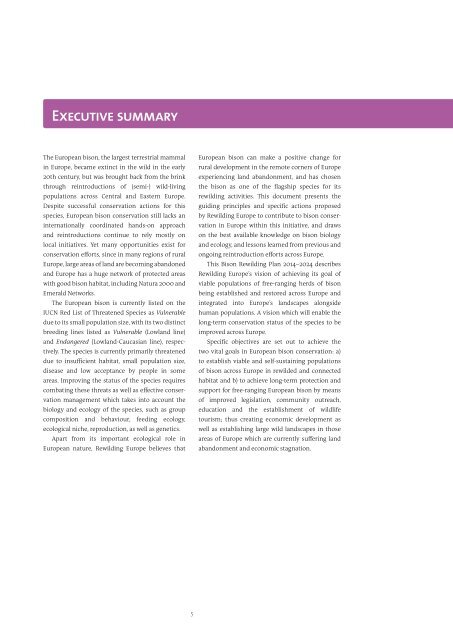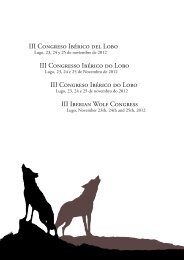Bison-Rewilding-Plan-2014
Bison-Rewilding-Plan-2014
Bison-Rewilding-Plan-2014
- No tags were found...
You also want an ePaper? Increase the reach of your titles
YUMPU automatically turns print PDFs into web optimized ePapers that Google loves.
Executive summaryThe European bison, the largest terrestrial mammalin Europe, became extinct in the wild in the early20th century, but was brought back from the brinkthrough reintroductions of (semi-) wild-livingpopulations across Central and Eastern Europe.Despite successful conservation actions for thisspecies, European bison conservation still lacks aninternationally coordinated hands-on approachand reintroductions continue to rely mostly onlocal initiatives. Yet many opportunities exist forconservation efforts, since in many regions of ruralEurope, large areas of land are becoming abandonedand Europe has a huge network of protected areaswith good bison habitat, including Natura 2000 andEmerald Networks.The European bison is currently listed on theIUCN Red List of Threatened Species as Vulnerabledue to its small population size, with its two distinctbreeding lines listed as Vulnerable (Lowland line)and Endangered (Lowland-Caucasian line), respectively.The species is currently primarily threateneddue to insufficient habitat, small population size,disease and low acceptance by people in someareas. Improving the status of the species requirescombating these threats as well as effective conservationmanagement which takes into account thebiology and ecology of the species, such as groupcomposition and behaviour, feeding ecology,ecological niche, reproduction, as well as genetics.Apart from its important ecological role inEuropean nature, <strong>Rewilding</strong> Europe believes thatEuropean bison can make a positive change forrural development in the remote corners of Europeexperiencing land abandonment, and has chosenthe bison as one of the flagship species for itsrewilding activities. This document presents theguiding principles and specific actions proposedby <strong>Rewilding</strong> Europe to contribute to bison conservationin Europe within this initiative, and drawson the best available knowledge on bison biologyand ecology, and lessons learned from previous andongoing reintroduction efforts across Europe.This <strong>Bison</strong> <strong>Rewilding</strong> <strong>Plan</strong> <strong>2014</strong>–2024 describes<strong>Rewilding</strong> Europe’s vision of achieving its goal ofviable populations of free-ranging herds of bisonbeing established and restored across Europe andintegrated into Europe’s landscapes alongsidehuman populations. A vision which will enable thelong-term conservation status of the species to beimproved across Europe.Specific objectives are set out to achieve thetwo vital goals in European bison conservation: a)to establish viable and self-sustaining populationsof bison across Europe in rewilded and connectedhabitat and b) to achieve long-term protection andsupport for free-ranging European bison by meansof improved legislation, community outreach,education and the establishment of wildlifetourism; thus creating economic development aswell as establishing large wild landscapes in thoseareas of Europe which are currently suffering landabandonment and economic stagnation.5



